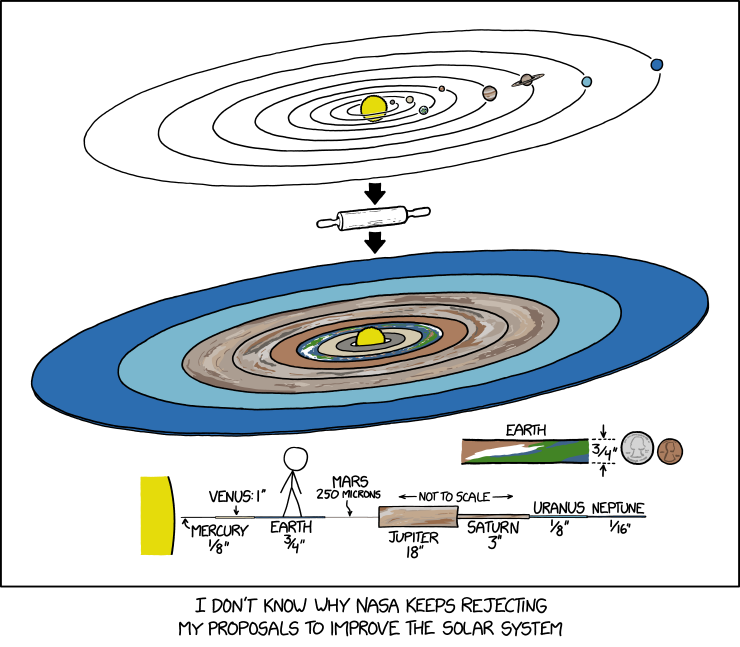Flatten the Planets

We'll turn the asteroid belt into ball bearings to go between different rings orbiting at different speeds.

We'll turn the asteroid belt into ball bearings to go between different rings orbiting at different speeds.
Planet Thickness in mm Mercury 1/8" 3.2 mm Venus 1" 25 mm Earth 3/4" 19 mm Mars 5/512" 0.25 mm Jupiter 18" 460 mm Saturn 3" 76 mm Uranus 1/8" 3.2 mm Neptune 1/16" 1.6 mm This comic depicts a situation where the planets in the solar system are flattened to create a ring system around the Sun. This may be inspired by the Alderson disk, a hypothetical megastructure intended to gain truly massive amounts of living space by constructing a literal disk of matter around a star. This would require several solar systems' worth of matter to do, and materials with a tensile strength beyond what is likely physically possible for any known form of matter. The planets of our solar system would not be suitable for this endeavor; alas, Randall apparently cannot comprehend why NASA is rejecting this proposal to "improve" the planets. This comic may be a follow-up to 2258: Solar System Changes.
The title text explains what would happen to the asteroid belt if this was done. He is proposing that the asteroids should be turned into ball bearings to go in between the planetary discs. There is enough matter in the asteroid belt to do this, dependent upon the size and distribution of the ball bearings used, and furthermore it implies that the discs would actually have small gaps between them. Unless the discs were made of material with impossibly high tensile strength, the whole structure would soon be torn apart by the relative forces between the inner and outer fringes of each disc trying to both 'orbit' at the rate more suited to a radial distance somewhere between the two, and crushing the bearings placed between adjacent ones. Although less so than with a single structural disc rotating at any single given compromise rotation (or not at all).
After this comic was released, NASA issued a three-page response, claiming they do not have any records of rejecting it. In their response, they outline the various strengths and weaknesses of Randall's idea. In the end, NASA decided not to fund the project.
Strengths:
- Simplifies navigation of the Solar System
- Reduces need to study orbital dynamics
- Simplifies seasonal migration patterns as seasons no longer exist
- Would demonstrate the first real-world use of incredibly strong materials as regular materials could not withstand those strengths (NASA cites Laplace 1787 and undergraduate problem sets since then)
- Would increase the amount of ice skating, cross country skiing, and Keplerian ice-boat racing in the Outer Solar System
- Increases Solar System's visibility to galactic neighbors
- Easier visualization of the Solar System
- Removes ambiguity of comet and asteroid origins
- The night sky would be darker and there would only be night
- Would cause an actual collision with Apophis instead of a near miss
- Enables new methods of exploring the Solar System
Weaknesses:
- Would require rapid transfer of orbital assets
- Mars would be very thin and liable to being pierced by interplanetary dust particles
- Does not include Pluto
- Time scale was not sufficiently addressed
- The proposal did not address the varying density of the planets
- The proposal did not include details on the environmental impact. They said they believe this was an intentional ommision
- Results in the end of all Solar eclipses
- Slides and roller coasters would be much less entertaining due to reduced gravity
- Not enough information on the thickness of Kuiper Belt and Oort Cloud
- Did not sufficiently account for Mercury heating up and expanding due to solar energy from the Sun
- May conflict with the exploration of the secrets of the Universe